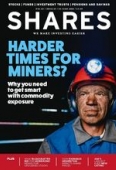Archived article
Please note that tax, investment, pension and ISA rules can change and the information and any views contained in this article may now be inaccurate.
Expert Investor: Find out what earnings momentum can mean for your shares

Recently there has been a lot of attention on the ‘growth’ versus ‘value’ debate and the thinking behind each investment style.
The successful development of Covid vaccines in November 2020 sparked an apparent rotation out of more expensive stocks which are growing their earnings rapidly and consistently into more attractively valued shares which are benefiting from pandemic recovery.
However, value is just one of five ‘factors’ which academics and quantitative analysts believe influences share price performance.
Value investing goes back to Graham and Dodd and the 1930s, while American economist William Sharpe identified beta as a factor in his 1964 paper on asset prices and what made them move (a stock with a high beta has a higher level of risk associated with it and therefore can be expected to move more than the market, both up and down).
Subsequently size or market capitalisation was identified as factor, along with price momentum, or the idea that winning stocks tend to keep winning.
EARNINGS NEWS DRIVES PRICES
In a paper published in 1993, researchers Narasimhan Jegadeesh and Sheridan Titman found that over short periods of up to three months, prices tend to revert to the mean (or go back to the average price after any initial move in either direction), but over say six to 18 months they tend to follow a trend, be it positive or negative.
This suggests that markets overreact to information in the very short term or the long term, causing mean reversion, but they under-react to news over the medium term, which in theory presents a significant opportunity for investors.
Further studies have shown fairly conclusively that price momentum is largely a function of earnings momentum, or more specifically what is known as the ‘second derivative’ – that is, not the rate of change of expectations, but the rate of change of the rate of change.
If a company consistently beats earnings expectations one quarter after another, and analysts are consistently raising their forecasts, it is more likely than not that the shares will go up.
Moreover, if earnings are rising faster than expected and faster than the average of the market as whole, it’s reasonable to expect that the shares will go up more than the market. Here we’re entering the realm of relative earnings momentum.
In the same vein, a company which continually undershoots expectations, or which just meets them, when the rest of the market is beating expectations, is likely to lag the market or even see its share price fall.
The first half of 2021 saw a phase of steady earnings upgrades for UK companies as the reopening of the economy spurred higher than expected demand.
GOOD NEWS TRAVELS SLOWLY
If a firm has been out of favour for a while, it can take quite a while for the market to latch onto good news and earnings upgrades.
A case in point is public sector outsourcer Serco (SRP), which along with the rest of the sector suffered a spectacular fall from grace a few years ago and was subsequently ignored by many investors.
However, with a great deal of self-help the firm cleaned up its act, worked off its onerous contract provisions and started plotting its recovery.
The first obvious sign the firm was back on track was the bold 2019 acquisition of Naval Business Systems in the US, which in one fell swoop doubled its revenue in naval support, a key growth area.
Since then the firm has gone on to win billions of pounds in new contracts and extensions, it surprised the market positively when it reinstated its earnings guidance in June 2020, and it has repeatedly raised guidance since.
When we look at the chart of 12-month forward earnings expectations for Serco, we can see they started rising steadily as early as January 2018 as analysts began nudging up their forecasts.
At about the same time the shares stopped falling and found support, but it wasn’t until the beginning of 2019 that the shares really responded to the upgrades, by which time forward earnings estimates were around 7p per share or double the level of mid-2017.
Impressively, earnings forecasts continued to rise through the pandemic and as of June 2021 the expectation was for earnings per share of 9.6p by June 2022.

BAD NEWS TRAVELS QUICKLY
The inverse scenario is when a company which has endeared itself to investors by consistently beating forecasts is no longer capable of delivering positive surprises.
A good example is bakery and food-on-the-go producer Greggs (GRG), which was something of a market darling pre-pandemic thanks to its decision to sell vegan sausage rolls in early 2019.
That sparked an explosion in the share price from £12.66 at the end of 2018 to almost £23 six months later, after the company had upgraded its sales forecast.
Yet when the firm maintained its guidance at the start of October 2019, analysts stopped raising their estimates, prompting a tell-tale wobble in the shares. From that point on, forecasts were progressively cut, even though the shares carried on rallying into the pandemic.
When a stock is on a lofty valuation – as Greggs was at the start of 2020 – at the very least it needs positive earnings momentum. In the event, the pandemic masked the rate of underlying downgrades and the stock corrected anyway, but investors who spotted the trend-change six months earlier could have reacted earlier.

Important information:
These articles are provided by Shares magazine which is published by AJ Bell Media, a part of AJ Bell. Shares is not written by AJ Bell.
Shares is provided for your general information and use and is not a personal recommendation to invest. It is not intended to be relied upon by you in making or not making any investment decisions. The investments referred to in these articles will not be suitable for all investors. If in doubt please seek appropriate independent financial advice.
Investors acting on the information in these articles do so at their own risk and AJ Bell Media and its staff do not accept liability for losses suffered by investors as a result of their investment decisions.

 magazine
magazine








